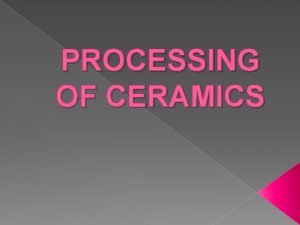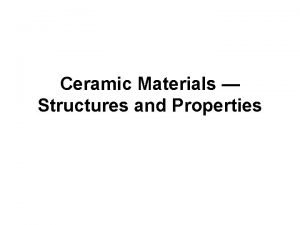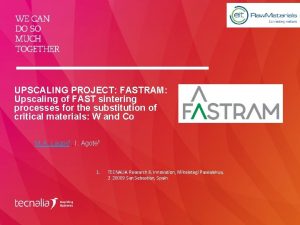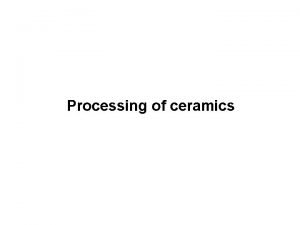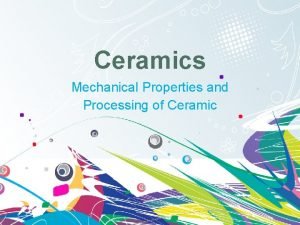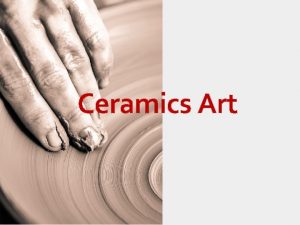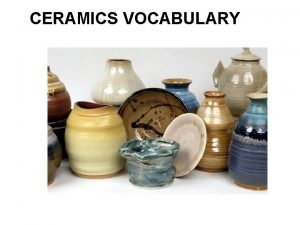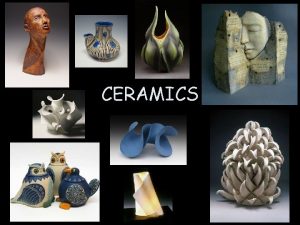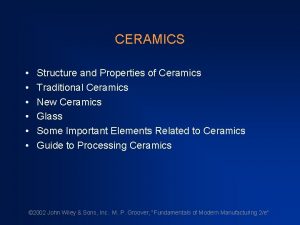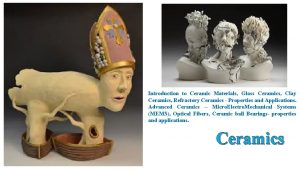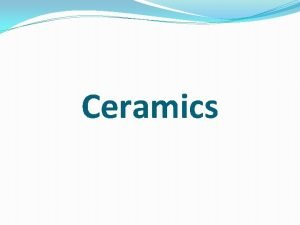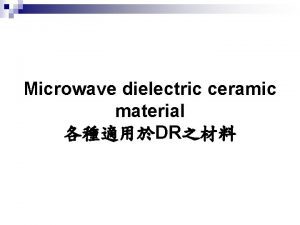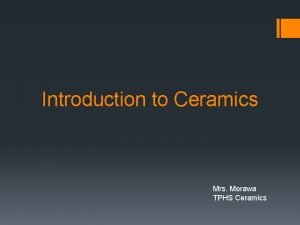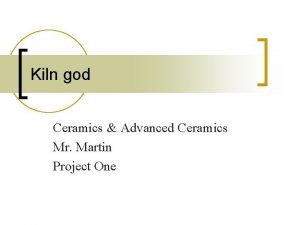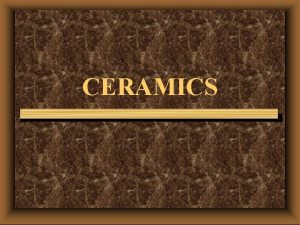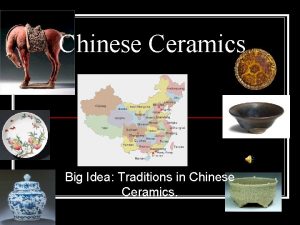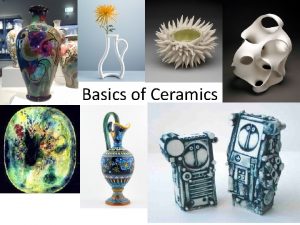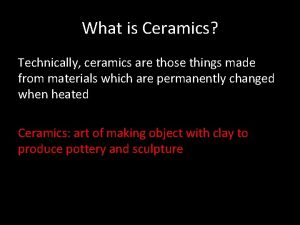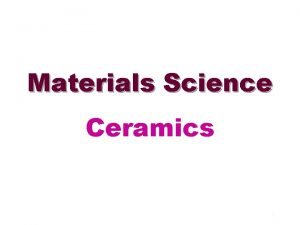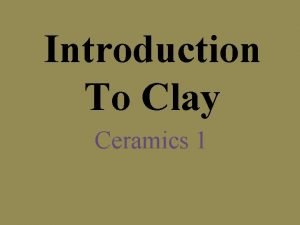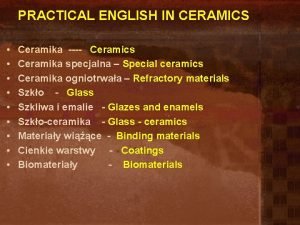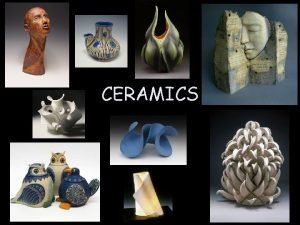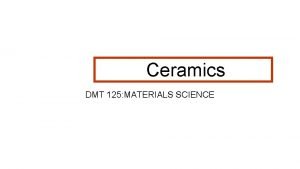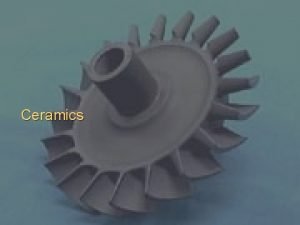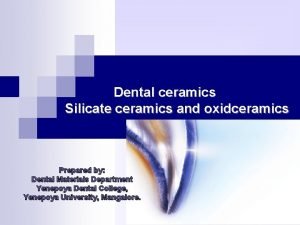PROCESSING OF CERAMICS CERAMIC A ceramic material is























- Slides: 23

PROCESSING OF CERAMICS

CERAMIC � � � A ceramic material is an inorganic compound consisting of metal or semimetal and one or more nonmetals. Are characterized by covalent and ionic bonding. More abundant and widely used compare to metal. Example: clay (brick and pottery), glass, cement, modern ceramic (tungsten carbide carbon boron nitride) General properties: high hardness, good electrical and thermal insulating characteristic, chemical stability, high melting temperature, brittle, posses virtually no ductility.

� Divide into 3 categories: 1. Traditional ceramics § Made of minerals occurring in nature such as mineral silicates, silica, and mineral oxides. § The primary products are fired clay (pottery, tableware, brick, and tile), cement, and natural abrasives such as alumina. § The clays are the raw materials used most widely in ceramics. They consist of fine particles of hydrous aluminum silicate that become a plastic substance that is formable and moldable when mixed with water. § The most common clays are based on the mineral kaolinite (Al 2 Si 2 O 5(OH)4). Other clay minerals vary in composition, both in terms of proportions of the basic ingredients and through additions of other elements such as magnesium, sodium, and potassium. § The powder are mixed with water to temporarily bind the particles together and achieve the proper consistency in shaping.

New ceramics § Made from synthetically produced raw materials and cover a wide spectrum of products such as cutting tools, artificial bones, nuclear fuels and substrates for electronic circuit. § New ceramics are based on compounds other than variations of aluminum silicate (which form the bulk of the traditional ceramic materials). New ceramics are usually simpler chemically than traditional ceramics such as oxide , carbides, nitrides and borides § Other substances are use as binders during shaping. After shaping, the green parts are sintered. § Generally posses superior mechanical or physical properties that are superior or unique compared to traditional ceramics § The distinction in these cases is based more on methods of processing than chemical composition.

3. Glasses. § Made from a silica (Si. O 2) which is usually combined with other oxide ceramic such as Si. O 2, Na 2 O, Ca. O, Al 2 O 3, Mg. O, K 2 O, Pb. O and B 2 O 3. § Silica, most commonly found as the mineral quartz in sandstone and silica sand. Quartz occurs naturally as a crystalline substance; but when melted and then cooled, it forms vitreous silica. Silica glass has a very low thermal expansion coefficient and is therefore quite resistant to thermal shock. § Glass is an inorganic, nonmetallic compound (or mixture of compounds) that cools to a rigid condition without crystallizing. § The starting material is heated to transform it from a hard solid into viscous liquid, then shaped into the desired geometry while in highly plastic or liquid condition. When cooled and hard, the material remains in glassy state rather than crystalizing. § Distinguish from other ceramics by their noncrystalline structure. § Example : window glass, light bulb glass, laboratory glassware, glass fibers.

PROCESSING OF TRADITIONAL CERAMIC Usual steps in traditional ceramics processing: (1) preparation of raw materials, (2) shaping, (3) drying, and (4) firing. Part (a) shows the workpart during the sequence, whereas (b) shows the condition of the powders.

PREPARATION OF THE RAW MATERIAL The shaping process for traditional ceramics require the starting material be in the form of paste � Paste is made of fine ceramic powders mixed with water and its consistency determines the ease of forming the material and quality of product. � Raw ceramic material usually occurs in nature as rocky lumps and reduction to powder is the purpose of the preparation step in ceramic processing. �

TECHNIQUE FOR REDUCING PARTICLE SIZE Techniques for reducing particle size in ceramics processing involve mechanical energy in various forms, such as impact, compression, and attrition. � The term comminution is used for these techniques, which are most effective on brittle materials, including cement, metallic ores, and brittle metals. � Two general categories of comminution: � › Crushing › grinding.

� Crushing › reduction of large lumps from the mine to

Crushing operations: (a) jaw crusher, (b) gyratory crusher, (c) roll crusher, and (d) hammer mill.

Mechanical methods of producing ceramic powders: (a) ball mill, (b) roller mill, and (c) impact grinding

The plastic paste required for shaping consists of ceramic powders and water. Clay is usually the main ingredient in the paste because it has ideal forming characteristics. The more water there is in the mixture, the more plastic and easily formed is the clay paste. � the ingredients of the ceramic paste can be divided into the following three categories: � › Clay - provides the consistency and plasticity required for shaping › Nonplastic raw materials - such as alumina and silica, which do not shrink in drying and firing but unfortunately reduce plasticity in the mixture during forming › Other ingredients - such as fluxes that melt during firing and promote sintering of the ceramic material, and wetting agents that improve mixing of ingredients.

SHAPING PROCESS � Slip casting � Plastic forming � Semi dry pressing � Dry pressing

SLIP CASTING Mixture is a slurry with 25% -40% water. � A suspension of ceramic powder called slip is poured into porous plaster of paris (Ca. SO 4 -2 H 2 O) mold so that water from mix is absorbed into the plaster to form a firm layer of clay at the mold surface. � It must be sufficiently fluid to flow into the crevices of the mold cavity, yet lower water content is desirable for faster production rates. � Sequence of steps in drain casting

PLASTIC FORMING � � � Includes a variety of methods, both manual and mechanized. The starting material require to have plastic consistency, achieved by 15% to 25% of water. This methods generally employ a mixture with lower water content so that the starting clay is stiffer. Hand modelling : creation of ceramic product by manupulating the mass of plastic clay into desired geometry. Hand throwing : use potter wheels that rotates on the vertical spindle, powered either motor or foot operated treadle. Most mechanized methods are characterized by much less manual participation such as jiggering, plastic pressing and extrusion. jiggering

SEMI DRY PRESSING Proportion of water content in the starting clay is typically 10% to 15% � Low plasticity and require very plastic clay. � Use high pressure to overcome material’s low plasticity and force it to flow into a die cavity. � Flash is often formed from excess clay being squeezed between the die sections � Semi dry pressing

DRY PRESSING � � � � The main distinction between semidry and dry pressing is the moisture content of the starting mix. The moisture content of the starting clay in dry pressing is typically below 5%. Binders are usually added to the dry powder mix to provide sufficient strength in the pressed part for subsequent handling. Lubricants also added to prevent die sticking during pressing and ejection. This is because dry clay has no plasticity and is very abrasive , there are differences between die design and operating procedures compared to semi-dry. Die must be made of hardened tool steel or cemented tungsten carbide to reduce wear. Because dry clay will not flow during pressing, the geometry of the part must be simple. No flash is formed and no drying shrinkage occurs so drying time is eliminated and good accuracy can be achieved in the final product

GLASSWORKING � Typical manufacturing sequence in glassworking is: The typical process sequence in glassworking: (1) preparation of raw materials and melting, (2) shaping, and (3) heat treatment

� � � The main component in nearly all glasses is silica, which is the primary source is natural quart in sand. The sand must be washed and classified. Washing removes the impurities such as clay and certain minerals that would cause undesirable coloring of the glass. Classifying – grouping the grains according to the size. (The most desirable : 0. 1 to 0. 6 mm) The various other components such as soda ash (Na 2 O) , limestone (source of Ca. O), aluminium oxide, potash (source K 2 O) and other materials are added in proper proportions to achieve the desired composition. Mixing done in batches, in amount that are compatible with the capacities of available melting furnaces. Glass melting is generally carried out at temperature around 1500 C to 1600 C for 24 to 48 hours.

The batch of starting materials to be melted is referred to as a charge, and the procedure of loading it into the melting furnace is called charging the furnace. � Glass melting furnaces can be divided into the following types � v Pot furnaces - ceramic pots of limited capacity in which melting occurs by heating the walls of the pot v Day tanks - larger capacity vessels for batch production in which heating is done by burning fuels above the charge v Continuous tank furnaces - long tank furnaces in which raw materials are fed in one end, and melted as they move to the other end where molten glass is drawn out for high production v Electric furnaces of various designs for a wide range of production rates.

SHAPING PROCESS IN GLASS WORKING � The shaping processes to fabricate glass can be grouped into only three categories: 1. Discrete processes for piece ware, which includes bottles, light bulbs, and other individual items 2. Continuous processes for making flat glass (sheet and plate glass for windows) and tubing (for laboratory ware and fluorescent lights) 3. Fiber-making processes to produce fibers for insulation, fiberglass composite materials, and fiber optics.

� Shaping piece ware: › Spinning › Pressing › Blowing � Forming of glass fiber › Centrifugal spraying › Drawing of continuous filaments � Shaping of flat and tubular glass › Rolling of flat plate › Float process › Drawing of glass tube

ASSIGNMENT Describe and draw an illustration for all shaping process used in glass working as stated above. Due date: 18 th November 2013
 Processing ceramics
Processing ceramics Ionic materials
Ionic materials Ceramic processing upscaling
Ceramic processing upscaling Ceramic processing upscaling
Ceramic processing upscaling Standard costing and variance analysis formulas
Standard costing and variance analysis formulas What makes material useful and harmful
What makes material useful and harmful Material culture examples
Material culture examples Refers to the knowledge language values customs
Refers to the knowledge language values customs สัญลักษณ์gd&t
สัญลักษณ์gd&t Material and non material culture examples
Material and non material culture examples Bottom-up processing examples
Bottom-up processing examples Parallel processing vs concurrent processing
Parallel processing vs concurrent processing Top-down processing
Top-down processing Neighborhood processing
Neighborhood processing A generalization of unsharp masking is
A generalization of unsharp masking is Top-down vs bottom-up processing
Top-down vs bottom-up processing Batch processing vs interactive processing
Batch processing vs interactive processing Point processing operations in image processing
Point processing operations in image processing What is primary and secondary processing
What is primary and secondary processing What is point processing in digital image processing
What is point processing in digital image processing Gloria suarez
Gloria suarez Histogram processing in digital image processing
Histogram processing in digital image processing Digital image processing
Digital image processing Opaque ceramics definition
Opaque ceramics definition
